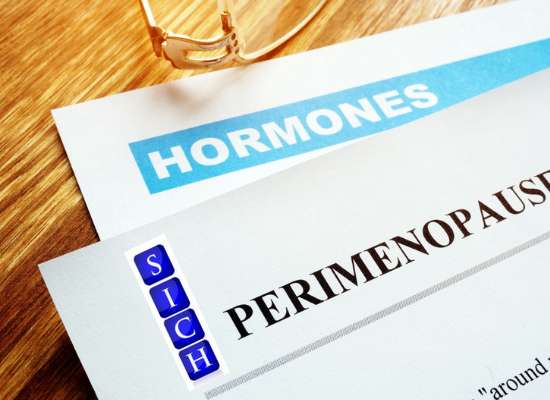Table of Contents
What is perimenopause?

Perimenopause is an initial phase of the menopausal cycle, also known as the menopausal transition. It consists of physiologic changes in our menstrual cycles that take us to our final menstrual period (FMP). Perimenopause continues until our periods have stopped for 12 months.
Perimenopause is divided into two stages: the early and late stages. The early stage is marked by skipped periods, and the second stage is marked by an absence of periods, ranging from 2 months to 12 months.
After 12 months without menstruation, the FMP is considered to have been reached, so we have now reached menopause and it is highly unlikely that menstruation will resume.
After this time, the chances of a recurring menstrual cycle or period are almost impossible. “What is Perimenopause” is a common question asked by women who are experiencing these changes and are unsure of what’s happening to their bodies.
Duration of perimenopause
There is no specific duration of the perimenopausal phase. The average time is 4 to 6 years, but it could be a few months to 10 years. It starts with the appearance of perimenopausal symptoms and moves towards menopause when our periods stop completely.
Perimenopausal symptoms continue until we reach our one day of menopause, that is, the day that marks one year without periods (also known as amenorrhea).[1]. The time after this day is known as postmenopause.
Most commonly, women begin menopause between 45 and 55 years of age, however, this can be earlier. Early menopause happens before the age of 45, and if menopause starts before 40 it is known as premature menopause.
So, perimenopause is the phase before menopause, the day after 12 months of no periods this is known as menopause, and the final phase is known as post-menopause.
What is the cause of perimenopause?
The underlying cause is the changing hormone levels in the female body when our ovaries gradually stop functioning. Our fluctuating oestrogen levels can cause different symptoms, such as high oestrogen levels can cause symptoms like PMS, and low oestrogen levels causing hot flushes or night sweats[2].
Common perimenopause symptoms
When people ask “what is perimenopause?”, they generally want to know what the perimenopausal symptoms are. The most common is irregular periods. Not all women experience perimenopause symptoms, around 1 in 5 don’t have any symptoms, while 1 in 5 will experience severe symptoms that disturb their daily life activities.
Hot flushes, mood swings, low sex drive, poor sleep, sore breasts, vaginal dryness, weight gain, tiredness, and muscle or joint ache are some of the other symptoms [3].
Hot flushes
Hot flushes are another common perimenopausal symptom and happen because of sudden changes in our body temperature. Firstly, you may feel the heat and then sudden chills. It can last from seconds to minutes. Other associated complaints from women are perspiration, blushing, and an increased heart rate.
At night, hot flushes can be so disturbing that they can cause us to wake up, and some women may need to change clothes because of excessive sweating [4].
The hot flushes start even before the beginning of perimenopause, with a frequency of 6 to 13 %. This increases in late perimenopause by up to 63 %. Late menopause shows the highest frequency of hot flushes [5].
Mood swings
Hormonal fluctuations from our decreasing oestrogen may also cause mood swings. We might feel anxious or depressed. Some women may feel emotions coming out of nowhere and can feel anger, exhaustion, clingy, or forgetful.
A decreased oestrogen level affects our mood by affecting the mood-balancing hormone, serotonin. Serotonin is usually known as the ‘happiness hormone’, and disturbances in its levels can bring on depressive and sad feelings in women.
Progesterone, another sex hormone, also drops during perimenopause. Low progesterone and high oestrogen levels at the same time also cause irritability and stress.
Improper sleep
Progesterone is associated with good sleep patterns, so when levels drop, this reduction can affect our sleep and mood badly. Reduced progesterone and poor sleep patterns (insomnia) can cause migraines, hot flushes, and depression [6].
The frequency of depressed mood is 29% in late perimenopausal women, and it can reach up to 34% [5].
Vaginal dryness
Reduced levels of oestrogen can also cause dryness in the vagina. This is another common perimenopausal symptom.
The vaginal lining, and its surrounding tissues, become thinner and less flexible. This is known as vulvovaginal atrophy.
Less lubrication, less acidic pH, and reduced sexual activities in perimenopause cause the vagina to shrink, and intercourse becomes more problematic and painful for women [7].
Other symptoms include increased urinary tract infections and frequent urination [8].
Muscle and joint aches
Perimenopause is commonly associated with muscle pain and joint aches. It is believed that oestrogen keeps our body’s joints lubricated and healthy, and decreased oestrogen levels cause stiffness and pain.
A cartilage cushion protects our joints from pain and inflammation. Oestrogen keeps cartilage healthy, and lower oestrogen levels weaken cartilage and bones, causing pain. Mostly the small joints are affected, but gradually large joints such as elbow and knee joints are also affected, which results in stiffness and limited movement. This condition is known as arthritis.
In women, menopause starts affecting the bones, causing arthritis. But it is not necessarily linked solely with perimenopause because ageing is also an essential factor in joint wear and tear [9].
Headaches
There is a strong association between perimenopausal hormonal fluctuations and headaches. The disturbed menstrual cycle triggers headaches from insufficient progesterone and oversensitivity to oestrogen.
Hormonal headaches are similar to regular migraines, and the associated symptoms of hormonal headaches are poor appetite, tiredness, joint aches, poor coordination, and cravings for chocolate, alcohol, or salt.
Hormonal fluctuations are the underlying cause of migraines or headaches in women during perimenopause. Some women may stop experiencing headaches once they reach menopause, but it is not valid in all cases [10].
In a menopause clinic, 42% of women complained of migraines, and a fifth reported daily headaches. 78% of women reported significant or severe disability from migraine attacks, according to the Headache Impact Test (HIT-6) [11].
Weight gain
Reduced oestrogen levels in perimenopause increase the fat storage in our abdomen and creates visceral fat. Visceral fat causes insulin resistance and type 2 diabetes, which increases the risk of heart disease and other health issues [12].
The link between weight gain and hormonal fluctuations is more common in women aged 42 to 50 years.
SWAN (Study of Women’s Health Across the Nation) investigated the effects of perimenopause among women, and their results showed that perimenopausal women had increased belly fat and less muscle mass [13]. Approximately, women increase their weight by around 5 pounds during perimenopause [14]. This is because an increased level of the hunger-stimulating hormone, ghrelin, increases the appetite. The hormone leptin, which gives a sense of fullness, lowers [15].
When do perimenopausal symptoms end?
Many women wonder what is perimenopause and how it will affect their lives. Understanding what perimenopause is, when the symptoms end and what to expect during this time can help women prepare for the changes that lie ahead.
Fluctuating hormones start to stabilise the nearer we get to menopause, and women can start to get relief from menstrual migraines.
Hot flushes increase at the end of the perimenopausal phase.
Sleep patterns can continue to bother us as we approach the end of perimenopause.
The good news, the mood swings start getting better!
As we are not all the same, despite the same age and ovary function rate, the duration and frequency of perimenopausal symptoms vary from woman to woman [16].
Treatment of perimenopause
Perimenopause itself does not need any treatment, however, treatment can help with symptoms. The possible treatments for perimenopausal symptoms are hormone replacement therapy (HRT), antidepressants, a healthy diet, calcium supplements, exercise, lifestyle modifications, and hypnotherapy.
Hypnotherapy is an effective and proven method for treating perimenopausal symptoms. It improves sleep patterns, treats the anxiety and stress, and improves hot flushes [18].
Evidence showing the frequency of perimenopause symptoms
A study in the Mediterranean region, on the menopausal symptoms that affect physical activity and life quality, showed the frequency of different symptoms – starting from the perimenopausal phase and continuing through the menopausal stage.
The most common symptoms were:
- hot flushes with a frequency of approximately 49%,
- anxiety with an approximate frequency of 69%,
- memory issues at about 53%,
- muscle and joint pain at 72% and
- fatigue at 73% [17].
What is perimenopause? – Conclusion
Perimenopause, an initial stage of menopause, brings many symptoms with it.
The common ones include irregular periods, hot flushes, weight gain, mood swings, headaches, vaginal dryness, improper sleep, and muscle and joint pains. These symptoms affect any woman’s life dramatically if they get severe.
These symptoms can be treated in many ways, and hypnotherapy is one of the effective natural methods to treat symptoms with no side effects.
References
1. Delamater, L., & Santoro, N. (n.d.). Management of the Perimenopause. PubMed Central (PMC). https://www.ncbi.nlm.nih.gov/pmc/articles/PMC6082400/
2. Perimenopause. (2021, August 8). Perimenopause | Johns Hopkins Medicine. Retrieved https://www.hopkinsmedicine.org/health/conditions-and-diseases/perimenopause
3. Perimenopause. (n.d.). Perimenopause | Healthdirect. https://www.healthdirect.gov.au/perimenopause
4. What Are Hot Flashes? What Can You Do About Them? (2022, July 3). WebMD. Retrieved February 6, 2023, from https://www.webmd.com/menopause/menopause-hot-flashes
5. Woods, N. F., & Mitchell, E. S. (2005, December 19). Symptoms during the perimenopause: prevalence, severity, trajectory, and significance in women’s lives. The American Journal of Medicine. https://www.amjmed.com/article/S0002-9343(05)00885-5/abstract
6. Living the Rollercoaster of Perimenopausal Mood Swings – Beverly Hills Therapy Group. (2021, April 22). Beverly Hills Therapy Group | Counseling and Mental Health. https://bhtherapygroup.com/living-the-rollercoaster-of-perimenopausal-mood-swings/
7. Changes in the Vagina and Vulva, Sexual Side Effects of Menopause | The North American Menopause Society, NAMS. (n.d.). Changes in the Vagina and Vulva, Sexual Side Effects of Menopause | the North American Menopause Society, NAMS. https://www.menopause.org/for-women/sexual-health-menopause-online/changes-at-midlife/changes-in-the-vagina-and-vulva#:~:text=During%20perimenopause%2C%20less%20oestrogen%20may,reduced%2C%20resulting%20in%20decreased%20lubrication.
8. Vaginal Dryness: Is It Perimenopause?: Gynecology and Obstetrics Medical Group: OB/GYNs. (n.d.). Vaginal Dryness: Is It Perimenopause?: Gynecology and Obstetrics Medical Group: OB/GYNs. https://www.gynobmedgroup.com/blog/vaginal-dryness-is-it-perimenopause
9. What causes menopause joint pain and how can you treat it? (n.d.). Healthily https://www.livehealthily.com/self-care/menopause-joint-pain
10. SEO, R. D. (n.d.). » Hormonal Headaches. &Raquo; Hormonal Headaches. https://www.menopausecentre.com.au/headaches/
11. Baxter, R. (2022, March 8). Migraine and perimenopause – The Migraine Trust. The Migraine Trust. https://migrainetrust.org/migraine-and-perimenopause/
12. Why Some Women Gain Weight Around Menopause. (n.d.). Why Some Women Gain Weight Around Menopause. https://www.healthline.com/nutrition/menopause-weight-gain
13. Sowers, M., Zheng, H., Tomey, K., Karvonen-Gutierrez, C., Jannausch, M., Li, X., Yosef, M., & Symons, J. (2007). Changes in body composition in women over six years at midlife: ovarian and chronological aging. The Journal of clinical endocrinology and metabolism, 92(3), 895–901. https://doi.org/10.1210/jc.2006-1393
14. The influence of sex hormones on obesity across the female life span – PubMed. (1998, December 1). PubMed. https://pubmed.ncbi.nlm.nih.gov/9929857/
15. Sowers, M. R., Wildman, R. P., Mancuso, P., Eyvazzadeh, A. D., Karvonen-Gutierrez, C. A., Rillamas-Sun, E., & Jannausch, M. L. (2008). Change in adipocytokines and ghrelin with menopause. Maturitas, 59(2), 149–157. https://doi.org/10.1016/j.maturitas.2007.12.006
16. Ltd, J., & Team, T. G. (n.d.). Manage the stages of perimenopause and understand how long you can expect perimenopause to last. – GlycanAge. Manage the Stages of Perimenopause and Understand How Long You Can Expect Perimenopause to Last. – GlycanAge. https://glycanage.com//self-care/menopause/how-long-does-perimenopause-last
17. El Hajj, A., Wardy, N., Haidar, S., Bourgi, D., Haddad, M. E., Chammas, D. E., El Osta, N., Rabbaa Khabbaz, L., & Papazian, T. (2020, March 24). Menopausal symptoms, physical activity level and quality of life of women living in the Mediterranean region. PLOS ONE, 15(3), e0230515. https://doi.org/10.1371/journal.pone.0230515
18. How can hypnosis help with perimenopause and menopause? — PositivePause. (2018, June 30). PositivePause. Retrieved February 6, 2023, from https://www.positivepause.co.uk/all-blogs/how-can-hypnosis-help-peri-and-menopause
